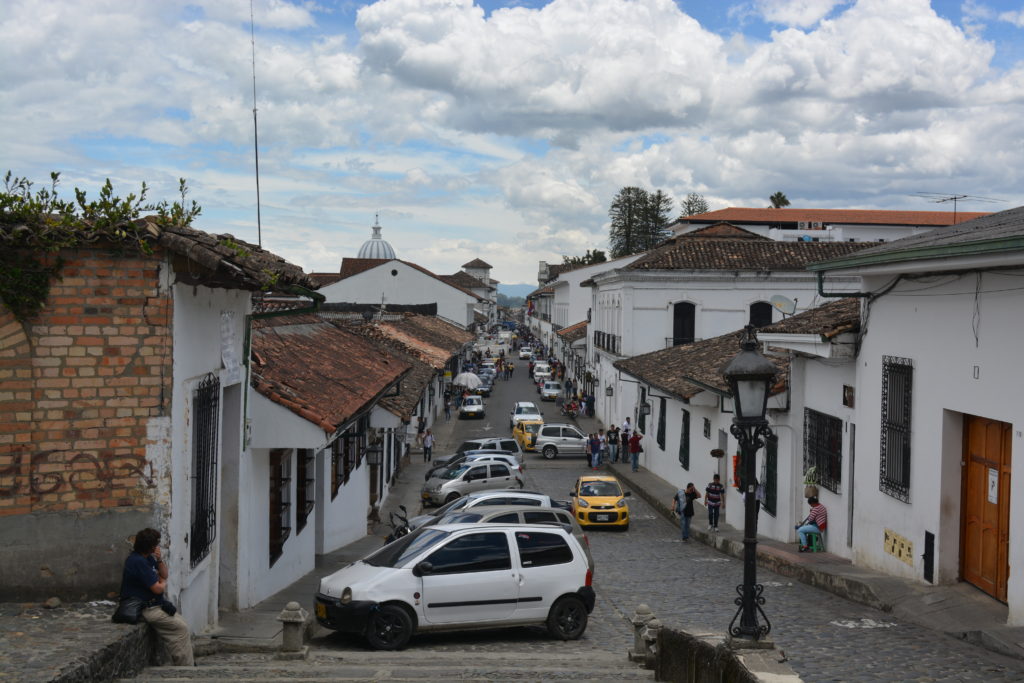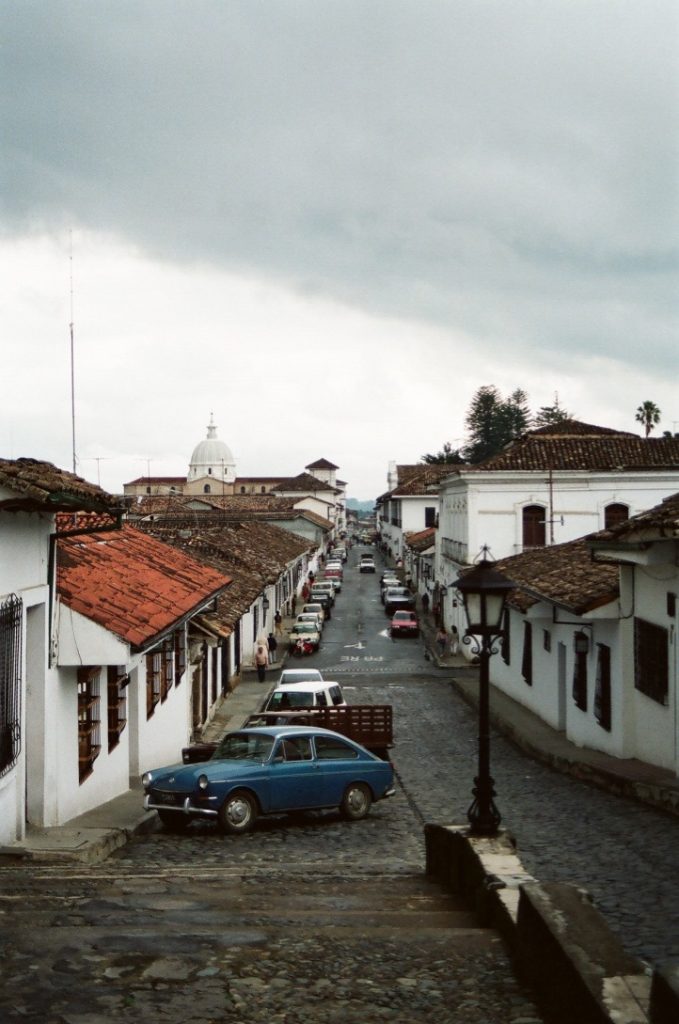Known as the “White City,” Popayán enchants visitors with its colonial architecture and historical significance. Our stay at Hotel Camino Real, an old colonial building that used to be connected to one of the many religious establishments in Popayán, positioned us close to the heart of the city, allowing easy access to its many attractions. Again, our route by bus followed the Pan American Highway for 251kms. On our bus was a group of Deportivo Cali football fans, both male and female, in their distinctive green shirts and many tattoos returning from a Copa Libertadores away match in Quito.
On our 2022 visit we stayed at the Hotel Colonial Popayán, a hotel in an old colonial building with internal courtyards. Our 2022 visit also coincided with the first round of Colombia’s presidential election. For the 24 hours around polling there was an alcohol ban, and a number of the country’s land borders were closed. Polling in Popayán appeared to be a very disciplined process, albeit with a lot of visible security, and with the electronic voting system, the results were quickly published after polling closed and were accepted as the right result as determined by the voters.

Geography, Climate, and Altitude
Perched at an altitude of 1,760 metres, Popayán enjoys a mild climate that attracts tourists year-round. Its location in the Andes provides stunning views of the surrounding mountains, while the whitewashed buildings reflect the city’s colonial heritage.
History and Economy
Popayán, founded on 13th January 1537 by Sebastián de Belalcázar, played a crucial role as an administrative and cultural hub during the colonial period of the Spanish Empire. Due to its strategic location on the trade route between Quito and Cartagena, the city prospered in the 16th and 17th centuries as a centre for commerce and gold mining. During this period, Popayán became known for its intellectual prominence, as many of Colombia’s most influential leaders, writers, and thinkers originated from the city, earning it the nickname “Ciudad Blanca” (White City) due to its elegant white-washed colonial architecture.
A key figure in the city’s history is Camilo Torres Tenorio, a revolutionary who played a significant role in Colombia’s fight for independence and was executed in 1816. Guillermo León Valencia, a 20th-century president of Colombia, was also born in Popayán, further cementing the city’s political importance.
The city’s economy remains diverse, with education being a major contributor due to the presence of multiple universities such as the University of Cauca (founded in 1827), which is one of the oldest and most prestigious in the country. Popayán’s Semana Santa (Holy Week) celebrations, recognised as Intangible Cultural Heritage by UNESCO in 2009, boost the city’s tourism sector, attracting visitors interested in its religious and cultural traditions. The local economy also benefits from agriculture, including coffee production and trade, as well as artisanal crafts.
The city has endured several challenges over the centuries, notably the 1983 earthquake, which caused significant damage to its historic buildings, including churches and colonial homes. However, Popayán has since been restored and continues to draw visitors for its rich historical and architectural heritage. Our very first visit to Popayán was in 1989 and at that time the city was still recovering from the devastation that earthquake caused.




Principal Sites
Parque Caldas
The main square, named after Francisco José de Caldas, a local scientist and hero of Colombia’s independence, is the heart of Popayán. The square has witnessed numerous key historical moments, from colonial events to modern-day celebrations. The gardens and trees surrounding the park create a peaceful urban space in contrast to the city’s bustling streets.



Parque Caldas, Popayán, Colombia
Catedral de Popayán (Basílica de Nuestra Señora de la Asunción)
The original cathedral, constructed in 1609, was destroyed by several earthquakes, leading to the construction of the current neoclassical building in the 19th century. Its reconstruction culminated in 1906, though the 1983 earthquake inflicted significant damage. Today, the cathedral stands as a symbol of Popayán’s resilience, with its large dome dominating the skyline. The white façade and ornate columns reflect its neoclassical design, while the interior houses important religious relics, including the “Señor de los Milagros” crucifix, believed to have miraculous powers.



Catedral de Popayán , Popayán, Colombia
Iglesia de San Francisco
Built in the 18th century, San Francisco is the largest and arguably the most beautiful colonial church in Popayán. The church’s baroque façade, crafted from local stone, is one of its most striking features, while inside, visitors can find intricately carved wooden altars and statues. The 1983 earthquake severely damaged the church, but subsequent restorations have preserved its splendour. Its bell tower, which once housed the famous “Caldas Bell,” dates to 1788 and remains a focal point of the city’s skyline.


Iglesia de Santo Domingo
Constructed in the late 16th century, Santo Domingo reflects the Spanish colonial architectural influence, with its striking stone façade and elaborate baroque altars. The church served not only as a place of worship but also as a symbol of Spanish power and religious dominance during the colonial era. Its beautiful altarpiece, gilded with gold, showcases the wealth and influence of the Catholic Church during this period.
Iglesia La Ermita
La Ermita, completed in 1546, is the oldest church in Popayán. Its modest size and simple design reflect its function as a rural chapel at the city’s periphery when it was first built. The church survived numerous earthquakes, making it a symbol of endurance. Inside, visitors can appreciate a blend of Mudejar and colonial styles, with beautifully crafted religious sculptures dating back centuries.



Iglesia La Ermita, Popayán, Colombia
Puente del Humilladero
This iconic bridge was completed in 1873, connecting the historic centre of Popayán with the northern part of the city. The 240-metre-long structure, made from brick and stone, features 12 elegant arches and is one of the most photographed landmarks in Popayán. Historically, it served as a crucial passage for travellers and goods, symbolizing the city’s economic and social development in the 19th century.



View of Popayán from Cerro del Morro, Colombia
Cerro del Morro
This hill provides stunning panoramic views of Popayán and the surrounding landscapes. Historically, Cerro del Morro served as a lookout point during periods of conflict, particularly during the Wars of Independence, offering strategic advantages due to its height.
Universities
Popayán has long been a centre of intellectual activity, with the Universidad del Cauca, founded in 1827, at the heart of this legacy. The university played a crucial role in shaping the region’s political and cultural landscape, producing several influential figures in Colombian history, including presidents and leaders of independence movements. Its continued importance solidifies Popayán’s status as a leading educational centre.
| Impact of the 1983 Earthquake The earthquake that struck in 1983 had a profound impact on Popayán, leading to widespread destruction. The recovery and restoration efforts have transformed the city, allowing it to reclaim its status as a cultural centre. Notably, renowned artist Fernando Botero created a painting reflecting the devastation, serving as a poignant reminder of the city’s resilience. This painting resides in the Mueso de Antioquoia in Medellin. |
Restaurants and Food
Popayán offers a culinary scene that blends traditional Colombian flavours with international influences. Hotel Camino Real, known for its colonial charm, features a restaurant offering local delicacies like empanadas de pipián (potato and peanut empanadas) and tamales, set in a refined atmosphere that highlights the city’s cultural heritage. For Italian cuisine, Restaurante Italiano y Pizzeria serves authentic pasta and wood-fired pizzas, attracting both locals and tourists with its cosy ambiance and handmade dishes. La Cosecha Parrillada is a top spot for Colombian parrillada (grilled meats) and specialises in hearty platters of grilled steak, chorizo, and chicken, which are perfect for sharing. Together, these establishments showcase the diversity of Popayán’s dining options, from upscale regional dishes to comfort foods.
Final Thoughts
Popayán’s charm lies in its harmonious blend of history, culture, and community. This “White City,” with its preserved colonial architecture and deeply rooted traditions, invites visitors to explore both its storied past and dynamic present. From walking its historic streets and admiring the beauty of restored churches to enjoying its vibrant food scene and academic heritage, Popayán reveals itself as a destination that celebrates resilience, continuity, and an enduring sense of place in Colombia’s cultural landscape.


Dates: 23/08/2018 to 25/08/2018, 31/08/2018 to 01/09/2018 and 27/05/2022 to 30/05/2022
